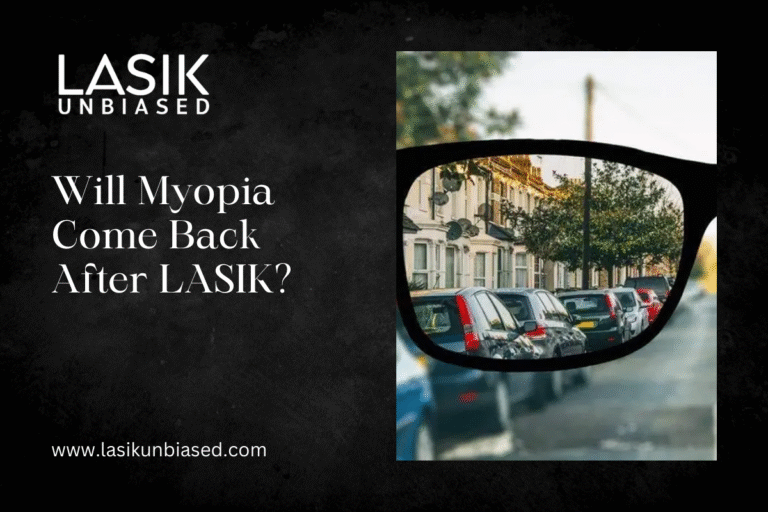If your prescription has been stable for at least a year, myopia (short-sightedness) generally does not return after LASIK.
However, certain factors like age, lifestyle, and eye health can influence long-term outcomes.
For anyone considering LASIK or those who’ve recently undergone the procedure, understanding whether myopia might return is crucial to managing expectations and making informed decisions. Here, we’ll explore the reasons behind potential myopia recurrence after LASIK, what you can do to prevent it, and how to maintain optimal eye health post-procedure.
How LASIK Corrects Myopia?
Before we look at whether myopia can come back after LASIK, it’s important to understand how the procedure works.
LASIK (Laser-Assisted in Situ Keratomileusis) is a refractive surgery that reshapes the cornea to correct vision. Myopia occurs when your cornea is too steep or elongated, which causes light to focus in front of the retina rather than directly on it. During LASIK, a laser is used to reshape the cornea’s curvature, allowing light to focus properly on the retina. The result? Improved vision without the reliance on glasses or contact lenses.
The success of LASIK is well-documented. Most patients achieve 20/20 vision or better, with high satisfaction rates worldwide. But while the procedure is effective at addressing existing myopia, it cannot prevent vision changes caused by ageing or other conditions.
Why Myopia Might Come Back After LASIK?
Although LASIK is considered a permanent solution to myopia, there are several reasons why short-sightedness might return after surgery.
1. Regression of Vision
Regression refers to the gradual return of refractive errors in the months or years following LASIK. This occurs in fewer than 10% of cases and is typically mild.
- Causes:
- Overhealing of the cornea, leading to slight changes in shape post-surgery.
- Fluctuations in vision due to pre-operative factors, such as high myopia (greater than -6.00 dioptres).
- Solution:
- Some patients may be eligible for a LASIK enhancement procedure to refine their vision correction if regression occurs.
Key takeaway: Most patients do not experience significant regression, especially if their prescription was stable beforehand.
2. Natural Ageing and Presbyopia
While LASIK corrects myopia, it does not stop the natural ageing process of your eyes. Around the age of 40, many people develop presbyopia, which impacts near vision due to the lens losing its flexibility. This is unrelated to LASIK but can make it feel as though myopia has “returned.”
- Signs:
- Difficulty focusing on nearby objects.
- Dependence on reading glasses, even if your distance vision remains sharp post-LASIK.
- Prevention:
- Explore options like monovision LASIK, where one eye is corrected for distance and the other for near vision.
Key takeaway: Presbyopia occurs naturally and doesn’t indicate that myopia has returned after LASIK.
3. Eye Strain and Poor Lifestyle Habits
Your daily habits could also influence post-LASIK outcomes. Spending excessive time on screens, lack of regular eye exams, or neglecting general eye care may contribute to symptoms resembling myopia.
- What to Watch For?:
- Blurred or tired vision after prolonged screen use.
- Dry eyes, a common side effect after LASIK.
- Prevention:
- Follow the 20-20-20 rule (look at something 20 feet away for 20 seconds every 20 minutes).
- Use artificial tears if you experience dryness.
Key takeaway: Healthy lifestyle choices can help maintain your LASIK results over the long term.
4. Underlying Eye Conditions
Some patients experience a recurrence of myopia due to underlying or undiagnosed conditions. For example:
- Keratoconus:
A progressive condition where the cornea thins and changes shape over time. This typically develops in younger patients and may make myopia return after LASIK.
- Cataracts:
Clouding of the lens can impact your vision in a way that mimics short-sightedness.
What You Can Do:
- Comprehensive eye examinations to identify and address potential issues at an early stage.
Key takeaway: Conditions like keratoconus or cataracts may lead to vision changes after LASIK, so ongoing monitoring is vital.
Can Myopia Be Prevented from Returning After LASIK?
While no procedure can guarantee permanent results, you can significantly reduce the likelihood of myopia recurrence with proper care and precautions.
1. Opt for LASIK at the Right Time
Timing can significantly influence the long-term efficacy of LASIK. Your prescription should remain stable for at least 12 months before undergoing the procedure. Age also plays a role; patients in their mid-20s to late 30s often see the best results because their vision is less likely to fluctuate.
2. Stick to Follow-up Appointments
Don’t skip post-surgery checkups. These allow your ophthalmologist to monitor the healing process and address minor issues before they escalate. Regular eye exams post-LASIK can also help detect signs of regression or other potential problems.
3. Adopt Healthy Eye Care Habits
Your lifestyle has a significant impact on your long-term visual health. Here are some tips:
- Minimise eye strain by taking regular breaks from digital devices.
- Always wear sunglasses to protect against UV rays, which can contribute to corneal damage.
- Stay hydrated and eat foods rich in antioxidants, like leafy greens and fish, to support overall eye health.
4. Consider Future Enhancements
If your vision changes significantly years after LASIK, you might explore enhancement procedures such as a LASIK retreatment. These are typically quick and less complex than the initial surgery, as less tissue needs to be removed.
Understanding the Risks and Long-Term Care
LASIK is one of the safest and most effective surgical options for correcting myopia, but understanding its limitations is key. It’s important to remember:
- LASIK addresses myopia caused by corneal curvature but cannot prevent age-related changes.
- Regular eye care, including checkups and lifestyle adjustments, plays a crucial role in preserving your vision.
With mindful attention to your eye health and realistic expectations, LASIK can provide clear, hassle-free vision for many years.
Is LASIK Worth It Despite the Possibility of Recurrence?
If you’re considering LASIK but are concerned about myopia returning, rest assured that most patients experience long-lasting benefits. The majority report improved vision for a decade or more, along with increased convenience and quality of life.
For those who have experienced mild regression, enhancements and other corrective options are readily available. Consulting with an experienced ophthalmologist will ensure you make an informed decision tailored to your unique eye health needs.
Take Control of Your Eye Health Today
While it’s rare for myopia to return after LASIK, ongoing care and informed decisions can help you maintain your post-surgery results. If you’re considering LASIK or have concerns about long-term outcomes, book a consultation with a trusted ophthalmologist for personalised guidance.
Clear vision begins with the choices you make today.


